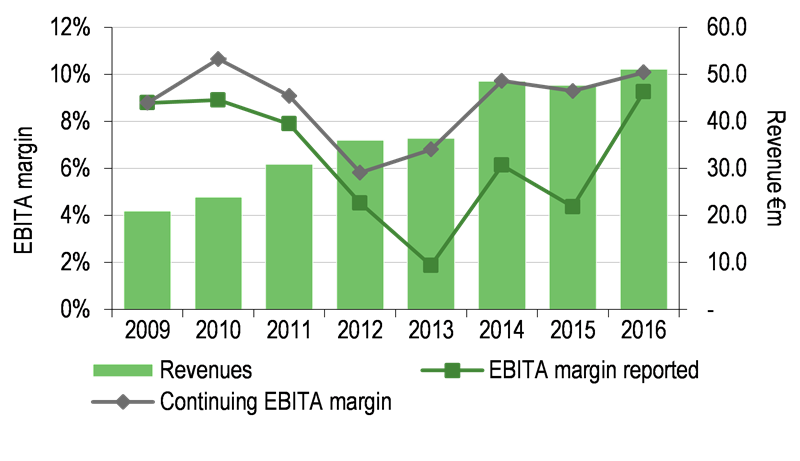Digital transformation: IT services industry
‘Digital transformation’ is a fairly generic term that can mean different things to different organisations. We interpret it as a catchall phrase reflecting the need for businesses to adapt to the onslaught of disruptive technologies that are affecting customer and employee behaviour since the advent of the internet and smartphones.
The effects of this evolution in consumer behaviour are clear in the steady march upwards of e-commerce. The German e-commerce sector has grown at a CAGR of 20% over the last five years and was worth €52bn in 2016 (bevh forecast), approximately 9% of total retail sales, making Germany Europe’s second largest e-commerce market, after the UK.
However, the digital lifecycle of a customer extends far beyond the final transaction to discovery, sharing (social media), payment, purchase and delivery of goods and services. The online ‘shopfront’ is the tip of the digital iceberg and to remain current, companies need to adjust their online strategies to differentiate themselves, adapt to new technologies and capture new opportunities. Given the profound nature of the shift in consumer behaviour, digital transformation is at the forefront of large companies’ strategic thinking. The September 2016 edition of business magazine ‘brand eins’ reported that 70% of German CEOs consider digital transformation as the most important challenge over the next three years.
While we consider the digital agency sector a structural growth segment, there remains a cyclical influence. Companies tend to invest in ‘transformational’ projects in periods of stable or rising business confidence (Exhibits 3 and 4). Despite the fairly volatile political climate in Europe, the economic climate in Germany is relatively stable; the Word Bank and the Bundesbank forecast a solid rate of real GDP growth in 2017 similar to 2016.
Exhibit 3: SZZ revenue vs GDP growth
|
Exhibit 4: SZZ revenue growth vs business confidence index
|

|

|
Source: SinnerSchrader, World Bank
|
Source: SinnerSchrader (Interactive Marketing division), Ifo
|
Exhibit 3: SZZ revenue vs GDP growth
|

|
Source: SinnerSchrader, World Bank
|
Exhibit 4: SZZ revenue growth vs business confidence index
|

|
Source: SinnerSchrader (Interactive Marketing division), Ifo
|
An integrated approach in an increasingly competitive market
The level of technical expertise required to launch a digital marketing strategy is increasing as companies look to harness more customer data across multiple platforms. This has, to an extent, led to a blurring of the roles of the chief marketing officer (CMO) and the chief technical officer (CTO) and, in response, of the line between traditional system integrators, media agencies and global consultancies, which are increasingly active in the space following a string of acquisitions over the last five years. Companies themselves are also experimenting with new approaches to try to harness the skills across departments and their service providers; Deutsche Bank, for example, in September 2016 opened a ‘Digital Factor’ where the bank’s staff, service providers and consultants will jointly develop the bank’s next-generation digital products and services.
SZZ has always differentiated itself by performing a hybrid role, bringing together both technical capabilities and creative excellence to offer an integrated approach to online sales and marketing. With 20 years in operation, it is regarded as a reliable partner to its clients and has a strong presence in the banking, telecoms, insurance, automotive and telecoms sectors, a number of which have been clients for over 10 years (Exhibit 5).
Exhibit 5: Key clients and segments, FY16
|

|
|
|
SZZ competes predominantly with the international digital agencies, most of which are now part of the international advertising networks, for instance Sapient, Razorfish (both Publicis), AKQA and Syzygy (both WPP) and, increasingly, against the digital arms of Accenture, IBM, and Deloitte.
SZZ’s integrated approach is a strong differentiator to the other independent German agencies, which tend to have either a communication/media focus (Syzygy, Plan.net) or a technical/platform focus (Hmmh, DMC) and in Germany SZZ ranks first among the independent companies in business transformation revenues and mobile platforms. That said, SZZ sees itself as a technology company first and is reputed for its technological ability and innovation. This is reflected in the make-up of its employees, c 40% of whom are engineers, 25% consulting staff and 22% creative (with the remainder administrative).
It supports its reputation and marketing efforts by hosting an annual JavaScript conference (JSConf EU) and a ‘digital business’ conference, which is attended by more than 1,000 delegates (NEXT).
Examples of projects that capture the spirit of what SZZ is trying to achieve include:
■
its relationship with Unitymedia KabelBW: after initially providing only the web-IT platform, SZZ is now responsible for the development and support of all digital customer channels, both the web-IT platform and digital communications;
■
SZZ maintains and operates Allianz’s website, supporting its goal to automate web-based insurance offers for standardised products; and
■
in Content Marketing, the flagship Curved.de is a ‘content marketing editorial’ established and run on behalf of E-Plus.
Exhibit 6: SinnerSchrader’s market position
|

|
|
|


















